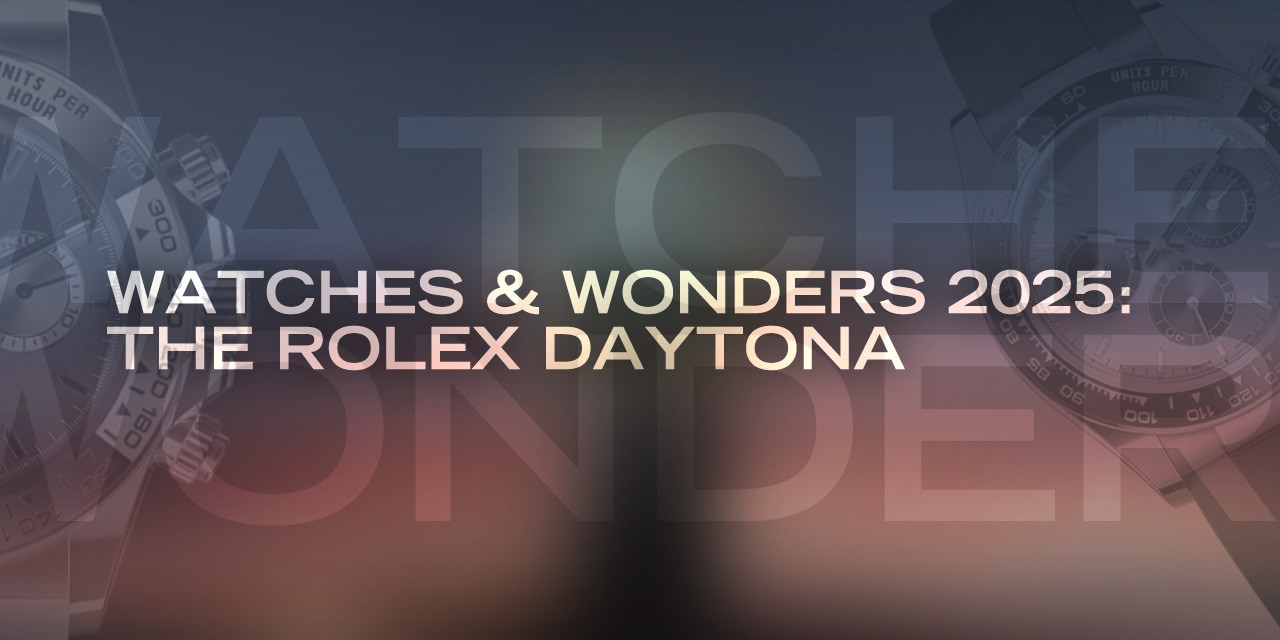All New Rolex Releases At Watches & Wonders 2025: The Rolex Daytona
If there’s one thing you can be relatively assured of during the great Rolex unveiling every April it’s that the brand’s two most stalwart offerings, the Day-Date and Datejust, will turn up with a host of new dial options.
In previous years, Rolex has come to market with a variety of fresh faces for their Classic Collection linchpins, ranging from the typically conservative to the wild and wacky.
2025 was different. The Datejust received just a single new addition, a nice deep red ombré look. The President got nothing.
Unusual though it is in the grand scheme of things, I suppose it does make sense this year, in a not-wanting-to-distract-from-the-main-event type way.
Rolex launches all-new watch collections with about the same regularity as George R.R. Martin releases new books, so the manufacture would obviously want its debut Land-Dweller to dominate as many of the global headlines as possible.
They did, however, arrive with a whole range of updated Daytona dials—seven in total, with at least two of them destined to become some of the most fought over Cosmograph variants of recent years.
Let’s take a look.
The Rolex Daytona 2025 Editions
Turquoise is a rare but not unheard of color for Rolex to use in its creations.
The aforementioned Day-Date wore turquoise, controversially, during the Stella dial era of the 1970s and ‘80s. A modernized version using real turquoise stone rather than a simple colored lacquer arrived in 2021. The year before that, the Oyster Perpetual briefly became one of the most desirable models in the Rolex portfolio when it was issued with a turquoise blue dial which was most definitely not meant to look like the Tiffany logo color in any way whatsoever.
This year, it was the Daytona’s turn. And pairing a turquoise dial with a yellow gold case, black totalizers and Cerachrom bezel, all on an Oysterflex strap has made this particular example of the ref. 126518LN one of the most eye-catching variants this side of the gem-dripping off-catalog watches.
Taking a look through the current Daytona collection, it’s easy to forget just how conservative their dial color range is, especially for such a well-stocked series. There are nearly 50 models in the Cosmograph family, but only a slack handful of shades on offer—mostly black, white, champagne, and the ice blue reserved for the platinum pieces.
This new addition is a true standout amongst the conventional, lending a vibrancy to the series it sorely needed. And, at a time of so much uncertainty in the world, there’s two things I can absolutely guarantee; the first is that the officially titled ‘turquoise blue and black’ Daytona will be a massive massive hit amongst the aficionados. The other is that literally no one will be calling it the ‘turquoise blue and black’ Daytona. This is, and always will be, the ‘Tiffany Blue’.
Return of a Favorite
Clearly, Rolex were also in agreement with brand followers that the Daytona range needed a bit of spicing up this year. As a result, 2025 saw the revival of a fan darling in the shape of the informally appointed ‘John Mayer’.
This was the nickname given to the previous generation ref. 116508 yellow gold model with a green dial. The watch got the title following a Hodinkee ‘Talking Watches’ video interview with the seven-time Grammy Award-winning musician and obsessive watch collector in 2019. In it, Mayer described the model as a‘sleeper hit’ that ‘I don’t think people totally understand…yet.’
Turns out he was on to something. Following the interview, demand for the reference went berserk, with virtually no chance to secure one at retail and secondary prices going through the roof, rising from around $35k to more than $100k in just a couple of years.
That iteration was retired in 2023, but it has staged a comeback this year with the latest generation ref. 126508.
Visually, the ref. 126XXX collection as a whole is very similar to the old one. The bezel gets a metal ring around the circumference, the sub dials are set fractionally wider apart and the lugs are slimmer with sharper beveling. The big change goes on inside, with the introduction of the latest Cal. 4131, benefitting from Rolex’s own Chronergy escapement, a new rotor and skeletonized bridges.
The green in this contemporary John Mayer’s dial is marginally lighter than on the original, and where that older model had color matching sub dials, this one has them in contrasting gold to match the case and bracelet.
As with the (not) ‘Tiffany Blue’, you can expect this version of the world’s favorite chronograph to be a huge draw, so if you have the opportunity to buy one through official channels, grab it and don’t let go.
The Best of the Rest
The remaining five new dials are split between space rock and chocolate, with a dash of blue for taste.
All of them are confined to precious metal models, some on bracelets, others on rubber.
The standalone is the ref. 126509, a white gold piece with non-Cerachrom, i.e. white gold, bezel. It gets the bright blue dial, which could be quite an uninspired move except for the subtle addition of a few hot red accents. You have to study it closely, but above each of the five-minute dagger-shaped indexes is a tiny red pip, and the color is also used on the inside edge of each sub dial’s ring. The ‘Daytona’ signature is in red too, as with the rest of the range.
Chocolate dials make a welcome return to the Everose examples. You can now find them on both the Oyster bracelet model as well as the Oysterflex version, and it is worth noting just how enormous an aesthetic difference a change in strap makes to the look of each one.
On the three-link rose gold bracelet we get a comparatively formal-looking visual, as if the watch is a piece of jewelry. With the Oysterflex, it is an out-and-out sports watch, ready for anything. Obviously one is no better than the other and it is all down to personal preference, but it never fails to surprise just how much distinction a new pair of shoes makes.
And it is a similar story with the meteorite. The white and yellow gold Oysterflex models now come with dials formed from genuine bits of celestial debris. While Rolex is predictably tightlipped about its sources, it is believed they still use wafer thin slices of Namibia’s Gibeon meteorite for their dials, as they have done for previous models.
The 4.5 billion year-old object fell to Earth around 100,000 years ago and was discovered in 1836. Rolex has been using it since the early 2000s and those special pieces favored with such exceptional dials are all unique. Each sliver of the meteorite has its own Widmanstätten pattern; the natural crystalline design caused by the iron-nickel alloy inside cooling over the millennia—by about 1°C for every million years of space travel.
This is more a reintroduction of meteorite dials for the latest Daytona watches rather than a new direction. The previous examples were discontinued in 2023, as with the original John Mayer.
But while they are usually found on the more conservative names in the portfolio—the Day-Date and Datejust have them, as does the white gold GMT-Master II—pairing them with an Oysterflex again as is the case with the Daytona calms down the serious overtones and gives them a more playful exterior.
It is rare to see them out and about because of the natural scarcity of the material, but they are always a delight.
Featured Photo: Mixed art by Oriol Mendivil for BKT Archive.






